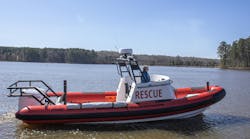The threat of terrorism also places communities at risk. Regardless of whether the threat is to a fixed facility, transportation or other potential acts of terrorism, every community should have plans in place for protection of the population should a hazmat release or terrorist incident occur.
In addition to protecting themselves, first responders must also protect the public from contact with hazardous materials. Besides establishing the "hot zone" and denying entry to the public, responders may also have to evacuate the public or shelter people in place.
Evacuation and isolation area distance information can be obtained from the green- or orange-bordered pages of the Emergency Response Guidebook (ERG). The green section provides information for materials that pose a health hazard. Inhalation is the primary route of exposure and this section is used only when no fire is involved. Distances provided in the green section are based on computer models of small and large spills. Spills are further classified by daytime and nighttime occurrences. Because air is more stable at night, vapor clouds can remain together for longer periods and thus travel greater distances than in the daytime. When materials are on fire, the orange section of the ERG is used to determine isolation and evacuation distances.
Training on the proper use of the ERG is very important for first responders. Resources are limited in the first minutes of a hazmat or terrorist incident. Responders may only be able to assist persons who are immediately in harm's way. Others will have to be moved or sheltered as the incident progresses.
If the public is to be evacuated from homes or businesses, an evacuation center needs to be established to receive and care for the needs of the evacuees. Workplaces and schools may have internal emergency plans that should be considered when evacuation or sheltering in place involves their facility. Emergency management agencies and Local Emergency Planning Committees (LEPC) have developed plans for the entire community covering notification, evacuation and sheltering-in-place procedures to be used during hazmat incidents. Evacuation plans should identify evacuation centers for those who are displaced.
State and local emergency management agencies also have the resources to notify the public through the Emergency Action System (EAS) (formerly the Emergency Broadcast System), sirens, and radio and TV broadcasts. By contacting the emergency management agency, responders can set in motion procedures for notifying and protecting the public.
Whether evacuated or sheltered in place, those in danger need to be notified of the danger and given instructions on what to do. People who would be placed in greater danger by evacuation than if they stayed in place can be sheltered. Residents of communities should be encouraged to have disaster supplies on hand in the event they have to shelter in place. These include:
- Flashlight and extra batteries.
- Portable, battery-operated radios and extra batteries.
- First-aid kits and manuals.
- Emergency food and water.
- Non-electric can openers.
- Essential medicines.
Residents who are asked to shelter in place should be given instructions on what to do to protect themselves. Many communities near major transportation routes or chemical plants encourage residents to put together shelter-in-place kits that contain essential supplies to prepare the home to exclude outside air exchange during an emergency.
Shelter-in-place procedures include the following:
- Bring pets inside and family members inside.
- Close and lock windows and doors.
- Seal gaps under doorways and windows with wet towels and duct tape.
- Seal gaps around windows and air conditioning units, bathroom and kitchen exhaust fans, and stove and dryer vents with duct tape and plastic sheeting, wax paper or aluminum wrap.
- Close fireplace dampers.
- Close off non-essential rooms such as storage areas, laundry rooms and extra bedrooms.
- Turn off air handling or ventilation systems.
Procedures should be established for reuniting family members who may become separated during an incident. During the day, parents are at work and children are at school or day care, so having a reunification plan can be very important. An out-of-state relative should be established as a contact so that all family members know whom to call in the event they become separated.
To carry out their required tasks, first responders must be trained, response plans developed and standard operating procedures (SOPs) written to govern responder actions at hazmat or terrorist incidents. As mentioned previously, the Occupational Safety and Health Administration (OSHA) does not define how many hours of training should be provided to response personnel at the awareness level or which training is acceptable for certification. The employer, whether it is a fire department or a private company, is responsible for identifying training that meets the awareness requirement for competencies. Employers then certify the employee to the awareness level. Refresher training must be provided each year.
Awareness training is available from a number of private and government sources, or organizations can develop their own awareness and refresher training. When deciding on a course to attend or in developing your own course, make sure all of the competencies of OSHA 29 CFR 1910.120 (q) and National Fire Protection Association (NFPA) Standard 472 are covered in the training. The training should also include an examination to verify the competency of those who were trained. Documentation should be kept by the employer and employee confirming the training, test score, certification and refresher training that have take place. Those records could be the first things asked for by OSHA or Environmental Protection Agency (EPA) investigators if they conduct an audit or respond to an employee injury, death or complaint.
NFPA 472 also addresses the competencies for first response to acts of terrorism as part of hazmat awareness. Many of the clues available to first responders for hazmat incidents may not be present for terrorist events. Responders will need to look to potential locations, including public assembly, public and government buildings, mass transit systems, places with high economic impact, telecommunications facilities, and places with historical or symbolic significance as clues.
Victims may also provide valuable clues as to what has happened. Responders should be aware of possible indicators of criminal or terrorist activity. This can include the presence of hazardous materials or laboratory equipment not usually found in the facility. Other clues include:
- Intentionally released hazardous materials.
- Unusual illnesses or deaths that cannot be explained.
- Odors or tastes.
- Unexplained skin, eye or airway irritation.
- Unexplained vapor clouds, mists and plumes.
- Victims twitching or exhibiting tightness in the chest, sweating, pinpoint pupils, runny nose, and nausea and vomiting.
Emergency responders should be able to identify specific actions to be taken if an incident is suspected to be a criminal or terrorist event. These include communicating the suspicion during the notification process, isolating exposed victims and documenting the initial observations. Hazards to responders at the scene of a terrorist incident include secondary devices, snipers, booby traps and secondary contamination from victims.
Responders should be able to identify the federal resources available to assist with a weapons of mass destruction (WMD) incident. Responders and dispatch personnel should be familiar with contact procedures as outlined in the local emergency response plan (ERP) or the organization's SOPs.
Response personnel should be able to classify chemical and biological agents into U.S. Department of Transportation (DOT) hazard classes. For example, nerve agents are classified as 6.1 poisons, phosgene is a 2.3 poison gas and biological materials are 6.2 infectious substances. Even though first responders may not have detection equipment, they should at least be able to describe methods of detecting chemical and biological agents. Responders should also be able to identify the heath risks associated with each of the chemical agent categories and biological agents. This information should include the NFPA 704 hazards, military designations, PEL/TWA and LD50 values.
First responders should be familiar with various physical and chemical characteristics of both hazardous materials and terrorist agents. Characteristics added to the first responder awareness for acts of terrorism include:
- Irritants (riot-control agents).
- Nerve agents.
- Vesicants (blister agents).
Hazmat and terrorist incidents can present significant challenges to first responders. Lack of training and resources place the first responders at a further disadvantage. Making sure that every first responder is trained to a minimum of the awareness level, with annual refreshers, will help ensure that hazmat and terrorist incidents can be handled safely and effectively.
CDP Graduates 5,000th Responder
On April 27, the U.S. Department of Justice's Center for Domestic Preparedness (CDP) at Fort McClellan, AL, held a celebration to commemorate the graduation of its 5,000th emergency responder. CDP opened on June 1, 1998, and took over operation of the former U.S. Army Chemical Training Center at Fort McClellan when the base closed in 1999.
CDP provides training to all levels of emergency responders to acts of terrorism. The center's unique Responder City and Live Agent Training Facility make it one of the best training experiences available for terrorism response. It is the only training facility in the world that provides hands-on training in a toxic agent environment for civilian emergency responders. Emergency responders from all 50 states, the District of Columbia and the territories have participated in the center's training programs - 44% firefighters, 33% law enforcement, 7% EMS, 6% hazmat technicians, 5% emergency management, 5% others and 1% public works.
CDP graduates from around the country were invited back to share in the 5,000th-graduate celebration. Visiting graduates were treated to a tour of facility improvements and given a briefing on future curriculum and facility development plans. CDP has also recently begun providing support for the 120-city training program that was formerly conducted by the Department of Defense; 15 cities remain to be trained. As part of the training, selected responders from each city will attend CDP.
CDP Director LZ Johnson opened the celebration ceremony, which included speeches by Alabama Senator Jeff Sessions, Congressman Bob Riley, and Acting Assistant Attorney General Mary Lou Leary. Patriotic selections sung by the Jacksonville State University Gospel Choir and "The Responders Song" sung by Rick Schlegel were very moving.
Lieutenant Lawrence R. Speck, a 21-year veteran of the Warren, MI, Fire Department, was honored as the 5,000th graduate of the training center. Speck is assigned to Engine Company 3 and is a member of the department's hazmat response team. He has an associate's degree in fire science and is a state-certified instructor. In addition, Speck is certified in high angle and trench rescue and is an emergency medical technician. His fire chief, Warren Cook, and Cook's wife Kim accompanied Speck to the ceremony.
Slots for the 2002 courses have been filled and there is a 1,600-student standby list. The center is working to secure additional resources to reach its potential capacity of 10,000 responders per year. For additional information visit the CDP website at www.ojp.usdoj.gov/osldps/training_cdp.htm. Robert Burke
Robert Burke, a Firehouse® contributing editor, is the fire marshal for the University of Maryland. He is a certified Hazardous Materials Specialist, and has served on state and county hazmat response teams. Burke is a veteran of over 18 years in the fire service, in career and volunteer fire departments, having attained the ranks of lieutenant and assistant chief, and served as deputy state fire marshal. He has an associate's degree in fire protection technology and a bachelor's degree in fire science, and is pursuing a master's degree in public administration. Burke is an adjunct instructor at the National Fire Academy. He is the author of the books Hazardous Materials Chemistry For Emergency Responders, published in 1997, and Counter-Terrorism For Emergency Responders, published in 1999. Burke can be reached on the Internet at [email protected].








